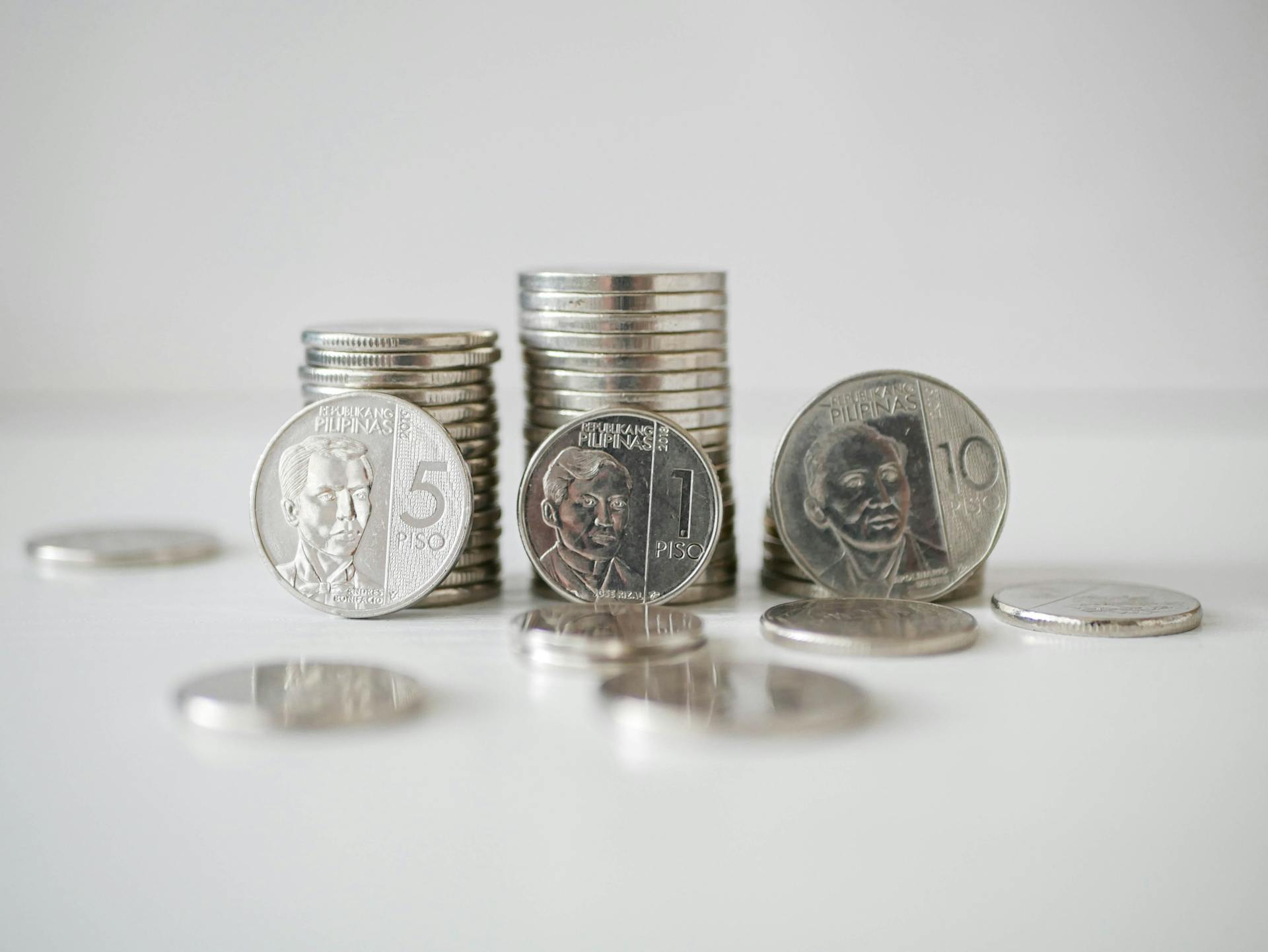
The Coinage Act of 1792 was a pivotal moment in American history, laying the foundation for the US currency system. It established the United States Mint and the dollar as the official currency.
The Act defined the dollar as equivalent to 24.75 grains of gold or 371.25 grains of silver. This standard would remain in place for over a century, shaping the country's economic landscape.
The Coinage Act also established the first US coins, including the half cent, cent, half dime, dime, quarter dollar, and half dollar. These denominations would become the backbone of American currency.
The Act's provisions for minting coins and regulating currency helped establish trust in the US financial system.
Suggestion: Are Presidential Dollar Coins Worth Anything
Key Provisions
The Coinage Act of 1792 was a game-changer for the United States, establishing the U.S. dollar as the nation's currency and creating a mint for national coinage.
The act gave Congress the sole authority to coin money, resolving the currency crisis that had plagued the nation since the Revolutionary War. This meant that the government could now control the flow of currency and prevent the kind of inflation that had occurred with the Continental dollars.
Expand your knowledge: 1501 South Mint Street Charlotte Nc
The Coinage Act of 1792 instructed the U.S. mint to strike coins of gold, silver, and copper of various denominations. This included the establishment of the copper cent, which was first introduced in 1787.
The act also established the U.S. dollar as the nation's standard unit of currency. This was a significant move, as it provided a sense of stability and consistency in the nation's financial system.
Here's a breakdown of the coins established by the Coinage Act of 1792:
The Coinage Act of 1792 also established the metallic composition and weight of each coin, ensuring that they were made with a certain standard of quality. This helped to maintain the value of the coins and prevent counterfeiting.
Implementation and Establishment
The Philadelphia Mint was established as part of the 1792 Act, with the law being passed by congress and signed by President George Washington on April 2, 1792.
Congress was given the authority to regulate coins, marking a significant step in the development of US currency.
On a similar theme: When Was the Federal No Surprises Act Introduced to Congress
The 1792 Act also made the United States one of the first countries to use a decimal system for currency.
This change had a lasting impact, and the 1792 Act remains the basis for US currency regulations to this day.
Although the law has been modified or superseded by subsequent pieces of legislation, its foundation continues to shape the country's currency system.
Authorization
The Coinage Act of 1792 was a pivotal moment in American history, and it all started with a law passed on April 2, 1792.
The law prescribed a 0.8924 fine standard for silver coins, which was based on the Spanish dollar standard.
This standard was to be used to mint coins that honored the official overall weight of 416 grains, as specified in the law.
However, the Mint Act of April 2, 1792, was not strictly followed in practice, leading to some interesting consequences.
The Mint produced coins in 1794 and 1795 that used a 0.900 fine standard instead of the prescribed 0.8924 standard.
Curious to learn more? Check out: Gold Standard Monetary
This meant that the coins had an excess of precious metal content, which was essentially wasted since the value of the coin was determined by its face value.
The excess precious metal content was calculated to be around 3.1616 grains, or 0.205 grams, per dollar received.
As a result, depositors ended up paying an additional 0.8% of their silver bullion to the mint when bringing it in to be minted into coins.
This added cost was a significant factor in the decline of bullion deposits brought to the mint in 1796 and 1797.
Consider reading: Golden Presidential Dollars
Understanding the Act
The Coinage Act of 1792 was a crucial regulation passed by Congress on April 2, 1792, that established the United States Mint in Philadelphia.
Prior to the Coinage Act, the challenges of not having a national coinage system had become a critical problem for the fledgling independent nation. The Articles of Confederation gave both the states and Congress the authority to coin money, but this led to the issuance of paper currency, called Continentals, which quickly lost value.
Additional reading: Coinage Act of 1873
In 1777, $1.25 of Continental currency could buy $1 in gold or silver coins. By 1781, the Continental had depreciated to the point that it took $100 in Continentals to obtain $1 in gold or silver coins.
The Coinage Act created U.S. eagles, dollars, cents, and sub-denominations of each, as legal tender at their face value or, for partial coins, in proportion to their weight. The act specified the metallic composition and weight of each coin in copper, silver, or gold, either pure or of a standard fineness.
The Coinage Act established the dollar as a basic unit of currency, fixed the price of gold and silver at 15 pounds of pure silver to one pound of pure gold, and defined a decimal system of larger and smaller denominations. Eagles, half eagles, and quarter eagles were minted from gold, and worth $10, $5, and $2.50, respectively.
Here is a breakdown of the coins established by the Coinage Act:
The Coinage Act also established the copper cent, with An Act to Provide For a Copper Coinage signed into law by President George Washington on May 8, 1792.
On a similar theme: Anchor Coinage
Sources
- https://www.investopedia.com/terms/c/the-coinage-act-of-1972.asp
- https://www.greatamericancoincompany.com/a/info/blog/the-coinage-act-of-1792
- https://www.statutesandstories.com/blog_html/coinage-act-of-1792-establishing-the-u-s-mint/
- https://coinsweekly.com/the-united-states-mint-230-years-power-to-coin-money/
- https://en.wikipedia.org/wiki/Coinage_Act_of_1792
Featured Images: pexels.com


